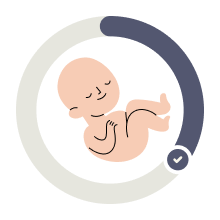At this stage, a lot of expectant mothers may experience full-on nesting instincts. While tidying and organizing is an excellent way to keep yourself occupied during the final stretch of pregnancy.
it’s crucial to avoid overexerting yourself—remember, you’re nine months pregnant! It’s advisable to conserve some of that energy for labor, as you’ll need it when the time comes.
“Have you captured a baby bump photo yet, whether it’s a posed shot or a candid moment?”
Pregnancy Week 38 Quick Facts
- At 38 weeks, you’re nine month two weeks pregnant
- You have 2 weeks until your due time “Calculate Your Due Date”
- This is your third trimester
Your Unborn Baby’s Size at 38 Weeks
How Big is Baby?
By the time you reach 38 weeks of pregnancy, your baby has grown to the size of a winter melon. They measure approximately 19.6 inches in length, and interestingly, their head circumference matches that of their abdomen. On average, babies at this stage weigh around 6.8 pounds is approximately 3,084 grams, which is quite similar to a typical birth weight. It’s fascinating to see how much your little one has developed and grown throughout the pregnancy journey.
Pregnancy Symptoms Week 38
The common symptoms experienced at 38 weeks of pregnancy revolve around the fact that you’re nearing the end of your pregnancy journey. Here’s how your body is affected:
Braxton Hicks contractions
- It’s normal to experience contractions at this stage, which may have been occurring for several weeks or have just started. If these contractions are not painful and subside when you change positions, they are most likely Braxton Hicks contractions, often referred to as “practice” contractions.
Trouble sleeping
- Feeling anxious or dealing with aches and pains can make it challenging to get a restful night’s sleep, despite being tired.
Increased vaginal discharge
- You may observe the presence of thick, mucus-like discharge with globs, known as the mucus plug. This is a normal occurrence as your cervix dilates in preparation for labor. Each bit of mucus plug released brings you closer to the onset of labor.
Itchy belly
- Given that your belly is stretched to its maximum extent at 38 weeks pregnant, it’s expected to be more sensitive. However, if you develop a rash, it’s important to inform your OB/GYN.
Swollen feet and Ankles
- As you reach 38 weeks of pregnancy, you have a valid reason to elevate your feet as much as possible to alleviate swelling in your feet and ankles.
Uncomfortable walk
- During the third trimester, walking can become uncomfortable due to several factors. Carrying extra weight, a uterus taking up most of the room in your abdomen, and pressure from the baby’s head between your legs can lead to the pregnancy waddle, making walking awkward.
As your body prepares for childbirth, your ligaments and joints begin to loosen up, affecting your center of gravity. This change may make you feel less stable on your feet and more clumsy than before. As a result, your chances of falling increase, so it’s essential to be cautious and take extra care while moving around.
Remember, each pregnancy experience is unique, and it’s always advisable to consult with your healthcare provider about any concerns or symptoms you may be experiencing.
Chances of Childbirth This Week
- Childbirth often differs significantly from what is portrayed on TV or in movies, especially when it comes to the moment when the water breaks. Do you know what to expect?
- According to a comprehensive study of over 34 million births in the United States, approximately 24% to 29% of pregnancies reach delivery between 37 and 38 weeks.
Water Breaking
- The amniotic sac, which holds the amniotic fluid surrounding your baby, is what breaks during labor. This event is commonly referred to as the rupture of the membranes. The sac consists of two membranes. When your water breaks naturally, it can be a sudden gush of fluid or a slow trickle. You might immediately recognize it, or you may have doubts.
Amniotic Fluid
- Clear like water
- Warm, similar to your body temperature
- Odorless
- Different from urine in smell
If you’re uncertain whether your water has broken, you can change your underwear, wear a pad, and observe. If the fluid was urine, nothing significant will likely occur. However, if it is amniotic fluid, the pad will continue to get wet.
Regardless of whether it’s a gush or a trickle, it’s important to contact your healthcare provider. They will likely ask you to come in for testing to confirm if your water has indeed broken. If it has, but you’re not experiencing contractions yet, your provider might suggest waiting for labor to start naturally over the next few hours.
If your water breaks at this stage of pregnancy, delivery, either through natural progression or induction, becomes imminent to minimize the risk of infection for both you and your baby. However, it’s worth noting that some people go into labor without their water breaking on its own.
Prenatal Tests and Doctor’s Appointments
You have a weekly appointment with your OB, including one this week.
- During these appointments, your doctor will ensure the baby is in a head-down position and check if the head has descended into the pelvis.
- A pelvic exam will be conducted to assess cervical dilation and effacement, indicating your body’s preparation for labor.
- Predicting labor based on dilation or effacement is unpredictable, as there is no “normal” timeframe. It could be hours or weeks after these signs appear.
- It’s possible to go into labor tomorrow even without any dilation.
- If necessary, a 38-week ultrasound may be ordered to measure the baby’s size.
- A biophysical profile may also be ordered to evaluate the baby’s breathing, movement, muscle tone, heart rate, and amniotic fluid levels.
- The result of the biophysical profile could influence the decision to deliver the baby earlier than the due date in certain cases.
Special Considerations
With only a week left until you and your baby reach the “full term” mark, you’re getting closer to meeting your little one. Take comfort in knowing that you’ve been preparing for this moment and try to shift your attention from just baby to also include yourself and your partner. If this is your first child, cherish these last moments as a couple before becoming a family of three. If you already have kids, make sure to set aside some special time to connect with them before the new baby arrives.
Developmental Milestones
By the 38th week of your pregnancy, your baby is likely shedding the fine, soft hair known as lanugo that covered their body in the uterus. Typically, most of this hair disappears before a full-term birth, although some hair may remain on the baby’s arms and shoulders. It’s fascinating to witness the various developmental changes that occur in your little one during this time.
Eyes:
At this point, your baby’s eye color may appear as a dark blue-gray shade, which may or may not be their final eye color. The amount of melanin protein your baby produces determines the ultimate eye color. However, it can take up to a year for the iris, the colored part of the eye, to achieve its final color, which could be brown, blue, green, hazel, or a blend of these shades.
Development:
From the 37th week until the 38th week and six days, your baby is considered “early term.” A pregnancy is considered full term at 39 weeks. Although your baby is almost ready for birth at 38 weeks, there is still some crucial development happening in the last week or two in the uterus.





